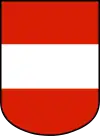Energy in Austria
Energy in Austria describes energy and electricity production, consumption and import in Austria.

Austria is one of the foremost producers of hydroelectric power in Europe. The most important power facilities are publicly owned; 50% of the shares of the large private producers are owned by provincial governments.
Overview
| Capita | Prim. energy | Production | Import | Electricity | CO2-emission | |
|---|---|---|---|---|---|---|
| Million | TWh | TWh | TWh | TWh | Mt | |
| 2004 | 8.18 | 386 | 115 | 274 | 64.2 | 75.1 |
| 2007 | 8.32 | 386 | 127 | 271 | 66.7 | 69.7 |
| 2008 | 8.34 | 387 | 128 | 274 | 68.5 | 69.3 |
| 2009 | 8.36 | 368 | 133 | 244 | 66.5 | 63.4 |
| 2012 | 8.42 | 384 | 134 | 273 | 70.4 | 68.5 |
| 2012R | 8.43 | 385 | 149 | 251 | 71.7 | 64.7 |
| 2013 | 8.48 | 386 | 141 | 246 | 72.2 | 65.1 |
| Change 2004-09 | 2.2% | -4.6% | 15.4% | -11.0% | 3.6% | -15.7% |
| Mtoe = 11.63 TWh Prim. . Prim. energy includes energy losses that are 2/3 for nuclear power[2]
2012R = CO2 calculation criteria changed, numbers updated | ||||||
Renewable energy
According to Austrian Environment Minister Nikolaus Berlakovich Austria has a target of 34% renewable energy by 2020 and 100% self-sufficiency in energy by 2050. In Austria will be 100,000 new green jobs up to 2020, Berlakovich hoped in the European Wind Energy Event 2013 by EWEA.[3]
Electricity
In 2000, net electricity generation was 58.8 TWh, of which 28.5% came from fossil fuels, 68.6% from hydropower, none from nuclear energy, and the remainder from other sources. In the same year, consumption of electricity totaled 54.8 TWh. Total installed capacity at the beginning of 2001 was 14.2 million kW. In 2000 petroleum accounted for 39% of energy consumption, natural gas 20%, coal 10%, nuclear energy 0%, and hydroelectric power 31%. During the winter, when there is less flowing water for hydroelectric power, domestic electricity demands must be supplemented by imports from neighboring countries.
| EU and Austria Wind Energy Capacity (MW)[4][5][6][7] | ||||||||||||||||
|---|---|---|---|---|---|---|---|---|---|---|---|---|---|---|---|---|
| No | Country | 2012 | 2011 | 2010 | 2009 | 2008 | 2007 | 2006 | 2005 | 2004 | 2003 | 2002 | 2001 | 2000 | 1999 | 1998 |
| - | EU-27 | 105,696 | 93,957 | 84,074 | 74,767 | 64,712 | 56,517 | 48,069 | 40,511 | 34,383 | 28,599 | 23,159 | 17,315 | 12,887 | 9,678 | 6,453 |
| 14 | Austria | 1,378 | 1,084 | 1,011 | 995 | 995 | 982 | 965 | 819 | 606 | 415 | 140 | 94 | 77 | 34 | 30 |
Oil
Oil, first produced in 1863, is found both in Upper Austria, near Wolfsegg am Hausruck, and in Lower Austria, in the vicinity of Vienna. After reaching a peak of about 3,700,000 tons in 1955, oil production gradually declined to 22,000 barrels per day in 2000. Natural gas production was 1.698 billion cubic metres in 1998, far short of domestic needs; consumption amounted to 6.862 billion cubic metres in that year.
References
- IEA Key World Energy Statistics Statistics 2015, 2014 (2012R as in November 2015 + 2012 as in March 2014 is comparable to previous years statistical calculation criteria, 2013, 2012, 2011, 2010, 2009 Archived 2013-10-07 at the Wayback Machine, 2006 Archived 2009-10-12 at the Wayback Machine IEA October, crude oil p.11, coal p. 13 gas p. 15
- Energy in Sweden 2010 Archived October 16, 2013, at the Wayback Machine Facts and figures The Swedish Energy Agency Table 8 Losses in nuclear power stations Table 9 Nuclear power brutto
- Fossil fuel subsidies are "public enemy number one" – IEA Chief EWEA 04 Feb 2013
- EWEA Staff (2010). "Cumulative installed capacity per EU Member State 1998 - 2009 (MW)". European Wind Energy Association. Retrieved 2010-05-22.
- EWEA Staff (February 2011). "EWEA Annual Statistics 2010" (PDF). European Wind Energy Association. Retrieved 2011-01-31.
- EWEA Staff (February 2012). "EWEA Annual Statistics 2011" (PDF). European Wind Energy Association. Retrieved 2011-02-18.
- Wind in power: 2012 European statistics February 2013
External links
 Media related to Energy in Austria at Wikimedia Commons
Media related to Energy in Austria at Wikimedia Commons
